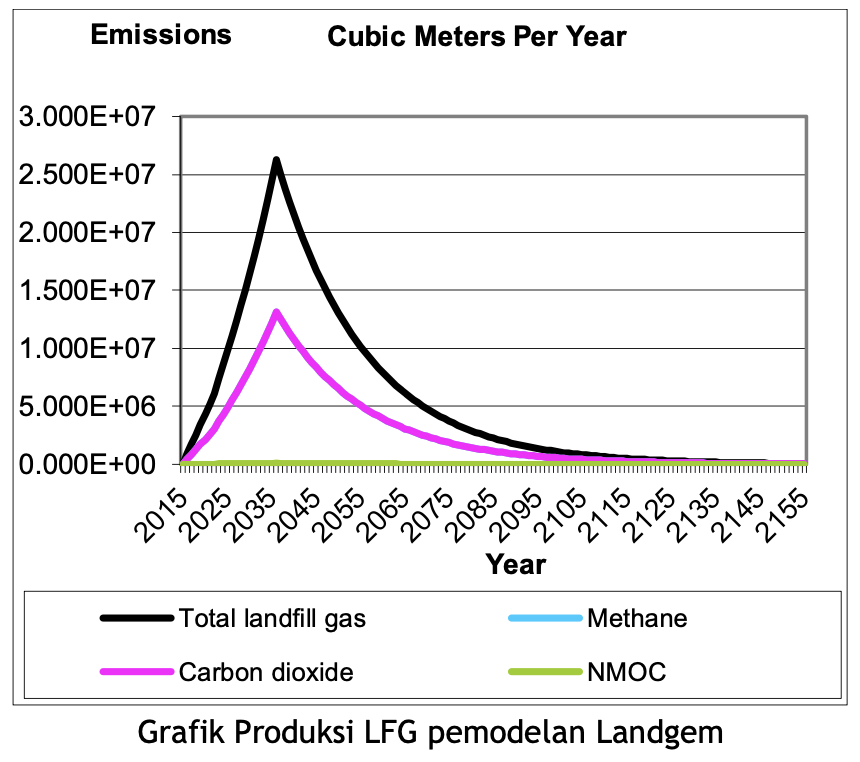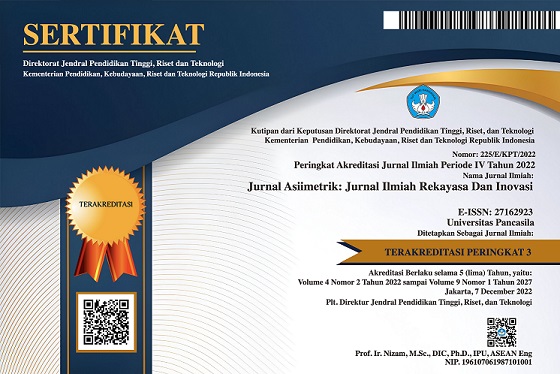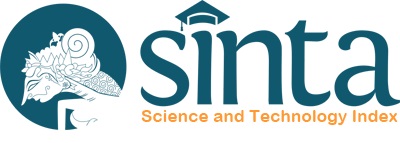Potensi Pemanfaatan Sumber Energi Alternatif Gas Metana untuk Pembangkit Listrik 3 MW Menggunakan Pemodelan Landgem (Studi Kasus: TPA Koya Koso Kota Jayapura)
Methane Gas Alternative Energy Resource Utility Potential for 3 MW Power Plant using Landgem Modeling (Case Study: TPA Koya Koso Kota Jayapura)
DOI:
https://doi.org/10.35814/asiimetrik.v5i2.5158Keywords:
methane gas, waste, Landgem, electrical powerAbstract
The volume of waste will continue to increase with increasing time, population, and economic growth in a city, district, or province. The city of Jayapura, as the center of the economy of the land of Papua, is the same way. The Koya Koso TPA management system for Jayapura City is currently landfill control, where the waste that has been collected at the TPA is stockpiled using layers of soil so that the piles are increasing in number day by day and causing problems including air pollution by methane gas, CO2, and other gases and limited land, thereby reducing the age of TPA Koya Koso Jayapura City. This study aims to determine the potential content of methane gas by modeling it using Landgem software and the potential capacity of electrical energy that can be generated. The results showed that the potential content of methane gas generated from Landgem modeling is 13,134,026 m3/year, or 8,762 tons/year, resulting in a potential capacity of electrical energy of 2,797.22 kW, or 2.8 MW.
Downloads
References
Angriani, N. (2017) Pemanfaatan Gas Metana Sampah Sebagai Energi Terbarukan (Studi Kasus TPA Puwatu Kendari). Thesis. Universitas Hasanuddin.
Bove, R. dan Lunghi, P. (2006) ‘Electric power generation from landfill gas using traditional and innovative technologies’, Energy Conversion and Management, 47(11), hal. 1391–1401.
BPS (2022) Kota Jayapura Dalam Angka 2019, Badan Pusat Statistik Kota Jayapura. Online: https://jayapurakota.bps.go.id/publication/2019/08/16/35d44178fcd58be1b0b8ba06/kota-jayapura-dalam-angka-2019.html (diakses: 25 Februari 2022).
Damanhuri, E. dkk. (2009) ‘Evaluation of municipal solid waste flow in the Bandung metropolitan area, Indonesia’, Journal of Material Cycles and Waste Management, 11(3), hal. 270–276.
EPA (2016) Landfill Gas Energy Project Development Handbook. USA: United States Environmental Protection Agency (EPA) [Cetak].
Farahdiba, A.U. dan Putra, H. (2014) ‘Gas Emissions Inventory of Methane (CH4) with First Order Decay (FOD) Method in TPA Piyungan, Bantul,DIY’, in The 3rd International Conference on Sustainable Built Environment. International Conference on Sustainable Built Environment, Indonesia: Faculty of Civil Engineering and Planning, Universitas Islam Indonesia, hal. 119-128.
Ikhsan, R. dan Syukriyadin, S. (2014) ‘Studi Kelayakan Pembangunan Pembangkit Listrik Tenaga Sampah (PLTSa) di TPA Kota Banda Aceh’, in Seminar Nasional dan Expo Teknik Elektro 2014. Seminar Nasional dan Expo Teknik Elektro 2014, Medan: Fakultas Teknik Universitas Syiah Kuala, hal. 146-151.
Jenbacher (2016) Jenbacher J420 Gas Engine. Online: https://www.jenbacher.com/en/gas-engines/type-4/j420 (diakses: 17 Maret 2022).
Karyana, Y. dan Rusliana, N. (2021) ‘Proyeksi Penduduk Jawa Barat Tahun 2025 – 2035 Menggunakan Metode Campuran dengan Data Dasar Sensus Penduduk 2020’, WELFARE Jurnal Ilmu Ekonomi, 2(1), hal. 26–35.
Kemenlhk (2022) Data Sampah Kota Jayapura 2015-2022, Sistem Informasi Pengelolaan Sampah Nasional (SIPSN) – Kementerian Lingkungan Hidup dan Kehutanan. Online: https://sipsn.menlhk.go.id/sipsn/public/data/timbulan (diakses 17 Juli 2022).
Monice, M. (2018) ‘Analisis Pemanfaatan Energi Dari Pengolahan Metode Landfiil Di TPA Muara Fajar Pekanbaru’, Rang Teknik Journal, 1(2), hal. 215–220.
Morgan, S.M. dan Yang, Q. (2001) ‘Use of Landfill Gas for Electricity Generation’, Practice Periodical of Hazardous, Toxic, and Radioactive Waste Management, 5(1), hal. 14–24.
Muljono, A.B., Mukti, K.B.K. dan Natsir, A. (2022) ‘Kajian Teknis dan Ekonomi Pembangkit Listrik Tenaga Sampah (PLTSa) Menggunakan Perangkat Lunak LandGEM TPA Kebon Kongok Gerung Lombok Barat’, DIELEKTRIKA, 9(1), hal. 68–79.
Narayanan, G. dan Shrestha, S.O.B. (2009) ‘Landfill Gas: A Fuel for IC Engine Applications’, in ASME 2007 Internal Combustion Engine Division Fall Technical Conference. ASME 2007 Internal Combustion Engine Division Fall Technical Conference, USA: American Society of Mechanical Engineers Digital Collection, hal. 51–60.
Rahmawati, I.U., Haddin, M. dan Suhartono, S. (2023) ‘Potensi Sampah Untuk Pembangkit Listrik Tenaga Sampah (PLTSa) Berbasis Metode Regresi Linier Berganda’, Jurnal Teknik Informatika UNIKA Santo Thomas, 8(1), hal. 1–8.
Rohman, A. (2022) ‘Perkiraan Potensi Gas Metana di TPA Tegalasri Wlingi dengan IPCC Waste Model dengan Metode Tier-1 First Order Decay’, JURNAL PROTEKSI: Jurnal Lingkungan Berkelanjutan, 2(1), hal. 1–10.
Sugiyono (2007) Statistika untuk penelitian. 1st edn. Bandung: Alfabeta [Cetak].
Wahyuni, S. (2011) Menghasilkan biogas dari aneka limbah. 1st edn. Jakarta: Agro Media Pustaka [Cetak].





























